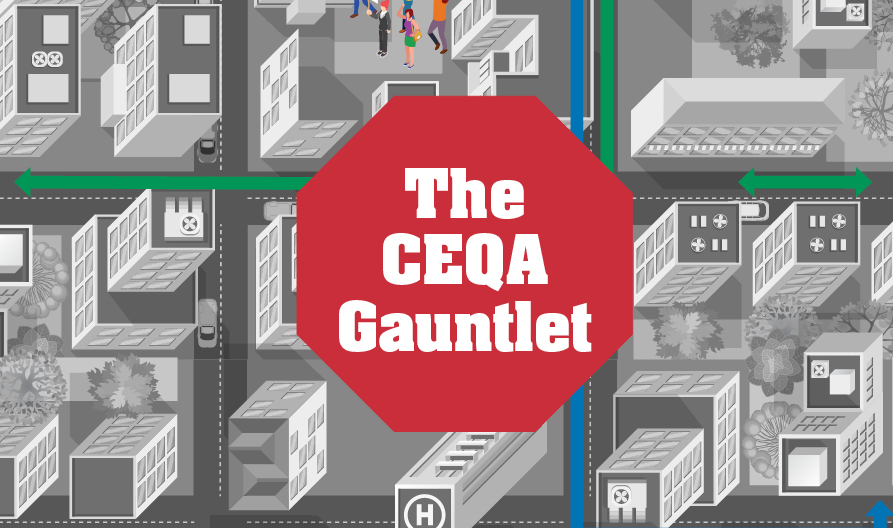A Case Study of What’s Wrong with California Government
In 2016, generous Angelenos approved Measure HHH, the $1.2 billion Homelessness Reduction and Prevention, Housing and Facilities Bond aimed at combatting Los Angeles’ homeless crisis. At the time, there were more than 30,000 people living on city streets or in shelters. The bond would pay for an estimated 10,000 housing units, tripling the city’s production of supportive housing.
And so began the CEQA Gauntlet.
The California Environmental Quality Act, or CEQA, was enacted more than 50 years ago to ensure that government evaluates the environmental impact of building projects in the state. But today, CEQA “threatens to grind the decision-making process to a halt,” wrote PRI senior fellow and top environmental attorney Chris Carr in “The CEQA Gauntlet,” a report he co-authored for PRI.
In a section of the report called “Real-Life CEQA Horror Stories,” Carr describes what happened to Measure HHH. To promptly deploy the funds, the city first needed to pass an ordinance to streamline the CEQA review process. The city’s attempt to reduce red tape was met with an avalanche of lawsuits challenging the ordinance. The Los Angeles Times’ editorial board got to the heart of the problem: “with so many CEQA suits, the real motive here appears to be plain old NIMBYism.” Building plans for the new housing units were put on ice. It took a carve out in 2019 (AB 1197), passed by the California legislature and signed by Gov. Newsom, to get the project moving again – three years after voters passed the bond measure.
Three more years have gone by since that CEQA exemption. Where are we now?
Of the 10,000 units originally promised to Angeleno voters, only 1,142 have been built according to a recent city audit. Moreover, only $347.5 million of the bond proceeds from the authorized $1.2 billion have been disbursed. The audit also found that 14 percent of the units built exceeded $700,000 each, and one project in pre-development is estimated to cost almost $837,000 per unit. To put this into context, in January 2022, the median price of a home in California was $765,580, and only a quarter of Californians can afford a home at this price. “The program,” wrote city Controller Ron Galperin, is “unable to meet the demands of the homelessness crisis,” while the cost of each unit has risen to “staggering heights.”
Among the key problems, says the report is how the funds have been distributed across project types: “Despite a mounting death toll of unsheltered residents, the City has focused almost exclusively on building supportive housing—typically from the ground up—which is expensive and takes several years to complete.”
Ann Sewill, general manager of LA’s Housing Department, highlighted other factors that made the project so expensive, including “requirements to pay prevailing wages and provide higher energy efficiency standards, accessibility standards and furniture.” In addition, she said that projects developed on publicly owned land, costing $837,000 per unit, included requirements for amenities such as clinics and child centers, raised costs.
The conclusion: If CEQA litigation doesn’t stop housing projects, the state’s climate change policies, union wage demands, and mismanagement will.
The tragedy is that since the bond measure was passed, homelessness has gone from a crisis to an uber-crisis. The homeless population now numbers more than 66,000 in Los Angeles County according to official estimates. But only half of the projects currently underway using HHH funds will be ready for occupancy by 2023 – seven years after Measure HHH was approved.
Now, a coalition of labor unions and other organizations are gathering signatures for a November ballot measure to tax the sale of multi-million-dollar properties to fund more housing for the homeless. The measure would create a 4 percent tax on properties sold for more than $5 million, and a 5.5 percent tax on properties sold for more than $10 million. According to the coalition’s estimates, the revenue from the proposed tax would supposedly create more than 26,000 housing units for homeless people over the next decade and help about 475,000 renters stay in their homes each year.
Six years after Measure HHH and only 1,142 housing units to show for it, is not what one could call a “proven record of success” by the city. If Angelenos agree to more spending, they should also ask for greater accountability from City Hall and CEQA reform from the Capitol.
Rowena Itchon is senior vice president of the Pacific Research Institute.

